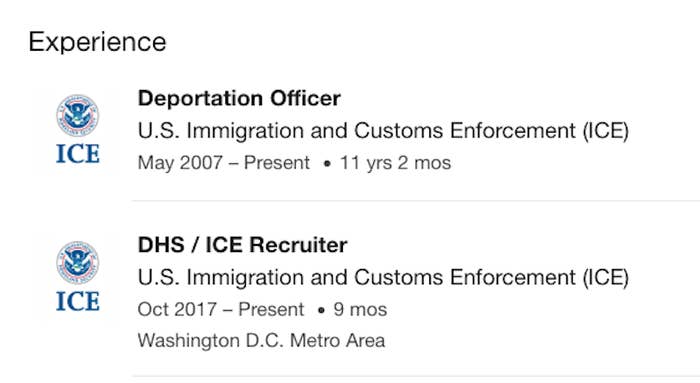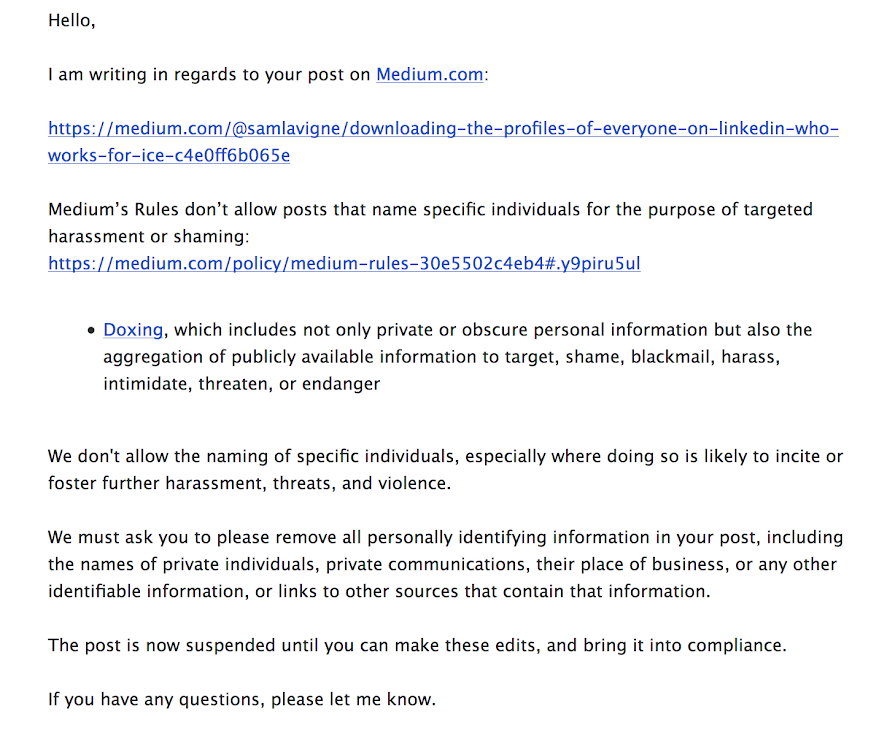
Medium, the blogging platform, and GitHub, a code repository, just suspended posts containing the LinkedIn information of Immigration and Customs Enforcement (ICE) employees. Both the post and the database, which was first removed from Medium and then from GitHub, were created by data artist Sam Lavigne.
Twitter also suspended Russel Neiss's bot account, @iceHRGov, that was automatically tweeting information from the database.
oh....
Lavigne scraped and downloaded the names, job titles, and city-level locations of ICE employees, and posted that data to GitHub (a website that hosts code repositories and was recently acquired by Microsoft). He wrote a blog post about the project on Medium, which linked to the database on GitHub.
Lavigne’s project was in response to the increasingly explosive situation at the US–Mexico border, where news reports are emerging daily about how children who’ve crossed the border into the US are being separated from their parents and detained.
Within hours, @Medium, @Twitter, and @github all censored @sam_lavigne for publishing a database of 1500+ LinkedIn profiles of ICE employees.
“Medium’s Rules don’t allow posts that name specific individuals for the purpose of targeted harassment or shaming,” the company wrote in an email to Lavigne, which he provided to BuzzFeed News. Specifically, Medium said the post violated its rule against “doxing,” or the “aggregation of publicly available information to target, shame, blackmail, harass, intimidate, threaten or endanger.”
GitHub said in an email that it "removed the project because it violates our community guidelines," which include "policies against use of GitHub for doxxing and harassment, and violating a third party's privacy."
Twitter did not immediately respond to a request for comment from BuzzFeed News.
The data has since been copied to a publicly available Google spreadsheet; Google did not immediately respond to a request for comment from BuzzFeed News.
In his original blog post, Lavigne said the dataset he downloaded contains the names of 1,595 people.
“While I don’t have a precise idea of what should be done with this data set, I leave it here with the hope that researchers, journalists and activists will find it useful,” he wrote. “I find it helpful to remember that as much as internet companies use data to spy on and exploit their users, we can at times reverse the story, and leverage those very same online platforms as a means to investigate or even undermine entrenched power structures.”
On Twitter, supporters of Lavigne’s project spread the link to the data; one said the list should be used to locate ICE employees and deny them “employment, services, and friendship.”
But others felt the scraping and downloading of LinkedIn profile data was unfair to the workers.
@DavidKlion @iceHRgov Much as I dislike ICE, I am opposed to DOXING people. It's one thing, to say, identify a person who is dragging a screaming child away from a parent, but identifying random ICE agents some of whom may be doing decent things behind the scenes is just plain wrong.
LinkedIn, which does not provide an easily accessible API, has sued individuals who’ve scraped its data.
In a statement regarding the ICE employee data, a spokesperson said, "We do not support or condone what immigration authorities are doing at the border, but we can’t allow the illegal use of our member data. We will take appropriate action to ensure our members’ data is protected and used properly.”
Previously, a US district judge ordered LinkedIn to allow third parties to scrape publicly shared data from its website.
LinkedIn, Medium, and ICE did not immediately respond to requests for comment.
Here’s the email from Medium to Lavigne in full:

UPDATE
This post has been updated to include a statement from LinkedIn.
UPDATE 2
This post has been updated to include a statement from GitHub.
UPDATE 3
This post has been updated with information regarding Twitter's suspension of an account.
